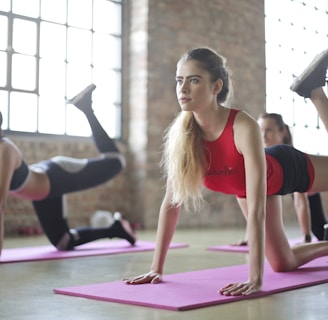How to Achieve Fitness from Home with No Equipment: The Power of Bodyweight Training
Achieving fitness from the comfort of your home without any equipment is not only feasible but also highly effective. Bodyweight exercises offer a versatile, accessible, and efficient means to enhance strength, burn fat, and improve overall health. This guide explores the benefits of bodyweight training and provides practical strategies to help you embark on your fitness journey without the need for any equipment.
3/25/20253 min read


Benefits of Bodyweight Training
1. Convenience and Accessibility
Bodyweight exercises can be performed anywhere, anytime, eliminating the need for a gym membership or specialized equipment. Whether you’re at home, in a park, or traveling, you can maintain your fitness routine with ease. This flexibility makes it easier to integrate exercise into your daily life, promoting consistency and long-term adherence.
2. Functional Strength Development
Unlike some machine-based exercises that isolate specific muscles, bodyweight movements engage multiple muscle groups simultaneously, enhancing coordination and balance. This functional strength translates to improved performance in daily activities and reduces the risk of injuries. For instance, exercises like squats and lunges mimic natural movement patterns, making them highly practical.
3. Scalability for All Fitness Levels
Bodyweight training is easily adaptable to suit individuals of varying fitness levels. Beginners can start with fundamental movements and progressively advance to more challenging variations as their strength and endurance improve. For example, a basic push-up can evolve into a diamond push-up or a one-arm push-up, providing continuous progression opportunities.
4. Effective Fat Burning
Incorporating high-intensity bodyweight exercises into your routine can elevate your heart rate and boost metabolism, leading to efficient calorie burning. Movements such as burpees, mountain climbers, and jumping jacks are particularly effective for fat loss. High-Intensity Interval Training (HIIT) workouts, which often utilize bodyweight exercises, have been shown to be highly effective in burning fat and improving cardiovascular health.
**Looking to add some basic equipment? Check out our brand new HFH Ultimate Gear Guide!
Key Bodyweight Exercises
To target all major muscle groups, consider incorporating the following exercises into your routine:
Upper Body:
• Push-Ups: Strengthen the chest, shoulders, and triceps. Variations include standard, incline, and decline push-ups.
• Dips: Focus on the triceps and chest muscles. Use a stable chair or bench to perform this exercise.
Lower Body:
• Squats: Engage the quadriceps, hamstrings, and glutes. Ensure proper form by keeping your back straight and knees aligned with your toes.
• Lunges: Target the legs and glutes while improving balance. Perform forward, reverse, or lateral lunges to vary the stimulus.
Core:
• Planks: Enhance core stability and endurance. Variations include side planks and plank with leg lifts.
• Bicycle Crunches: Work the obliques and rectus abdominis, promoting core strength and definition.
Full Body/Conditioning:
• Burpees: Provide a full-body workout that boosts cardiovascular fitness and burns calories.
• Mountain Climbers: Engage multiple muscle groups while elevating the heart rate, aiding in fat loss.
**Want some great workout templates that can be used for bodyweight exercises? Check out our Resources Page!
Structuring an Effective Bodyweight Workout
To create a balanced and effective workout, consider the following structure:
1. Warm-Up (5-10 minutes): Prepare your body with dynamic movements such as arm circles, leg swings, and gentle jogging in place.
2. Workout Routine:
• Circuit Training: Perform a series of exercises back-to-back with minimal rest. For example:
• 10 Push-Ups
• 15 Squats
• 20 Mountain Climbers
• 30-Second Plank
Repeat the circuit 3-4 times, resting for 1-2 minutes between rounds.
• Tabata Training: Engage in 20 seconds of intense exercise followed by 10 seconds of rest, repeated for 4 minutes. This method is effective for exercises like burpees or jumping jacks.
3. Cool Down (5 minutes): Conclude with static stretches focusing on major muscle groups to promote flexibility and aid recovery.
Tips for Success
• Consistency: Aim for at least 3-4 sessions per week to achieve noticeable results.
• Progressive Overload: Gradually increase the difficulty of exercises or the number of repetitions to continue making progress.
• Rest and Recovery: Allow adequate rest between workouts to enable muscle repair and growth.
• Nutrition: Support your fitness regimen with a balanced diet rich in whole foods to fuel your workouts and aid recovery.
Conclusion
Embarking on a fitness journey from home without equipment is both practical and rewarding. By leveraging the power of bodyweight exercises, you can achieve significant improvements in strength, endurance, and overall health. Embrace the simplicity and effectiveness of these workouts, and experience the transformative impact they can have on your fitness and well-being.
References
1. Harvard Health Publishing. “The Advantages of Body-Weight Exercise.” https://www.health.harvard.edu/exercise-and-fitness/the-advantages-of-body-weight-exercise
2. Healthline. “30 Moves to Make the Most of Your At-Home Workout.” https://www.healthline.com/health/fitness-exercise/at-home-workouts
3. Men’s Health. “Unlock True Strength with These 20 Bodyweight Exercises.” https://www.menshealth.com/fitness/a26202141/best-bodyweight-exercises/








